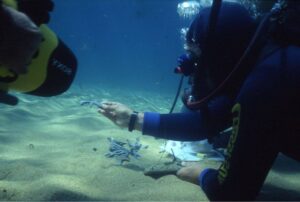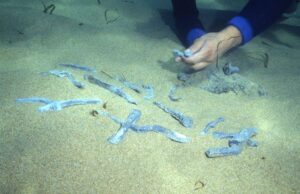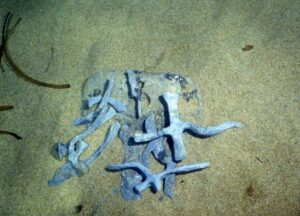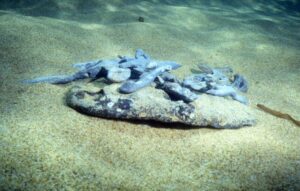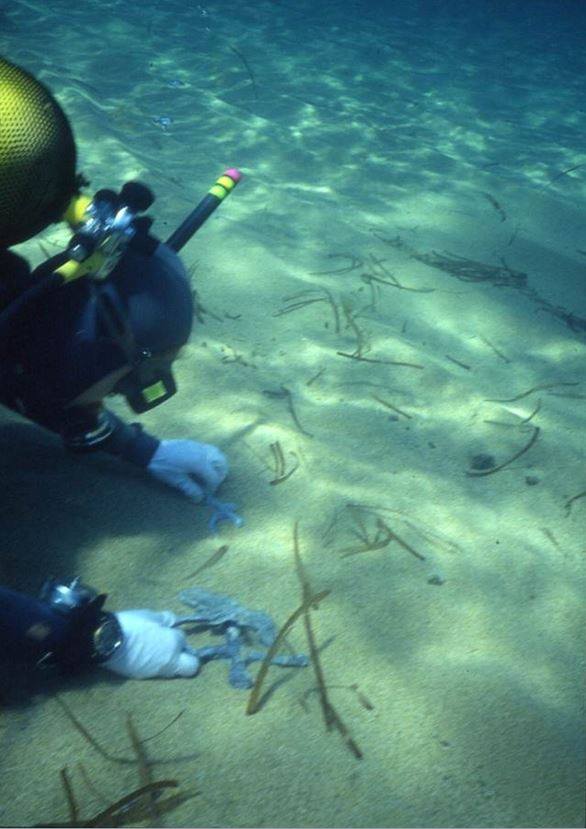by Giorgio Valdès
In his book “Hic NU Ra, tale of another Sardinia,” Nicola Porcu, professional diver and former honorary Inspector of the Superintendency before his passing in August 2015, reported a comment by Giovanni Lilliu regarding the discovery of the wreck of a nuragic ship not far from the coast of Arbus. The scientific research for this discovery was entrusted to the underwater archaeologist Emanuela Solinas, in collaboration with the Neapolis Archaeological Group of Guspini and with the technical assistance of the O.T. Sub company of Nicola Porcu himself. Lilliu specifically wrote that “…To the various materials of nuragic origin not far from the coast of Arbus, a new important testimony of trade between Sardinia and Etruria is now added. The recent finding on the seabed near Arbus…should be related to a wreck of a nuragic ship that sank, perhaps while on its way to Etruria. These finds are a significant clue confirming the hypothesis of commercial activities in the Early Iron Age, conducted directly by the Sardinians…”.
The archaeologist Luciana Tocco also reported on this discovery in a notebook published in 2009 by the Department of History at the University of Sassari, from which we have extracted some excerpts:
<< The site of Rio Dom’e S’Orcu was known since the 1920s due to occasional archaeological finds; from the early 1970s, various ingots of lead and tin were also recovered at sea, in the area immediately in front of the beach. The first report to the Archaeological Superintendency of the provinces of Cagliari and Oristano, submitted by Tarcisio Agus, dates back to the early 1980s and initiated investigations assigned to Giovanni Ugas of the Archaeological Superintendency of Cagliari and Oristano in September 1982. The Mountain Community of Monte Linas, in agreement with the Archaeological Superintendency, then commissioned the company OT SUB of Nicola Porcu and the Neapolis Archaeological Group to conduct surveys along the coast of the marina of Arbus, where the presence of underwater deposits had already been reported. The surveys were carried out in several phases and archaeological material in lead was recovered, while no elements pertaining to the hull were found. The first mention in literature of the archaeological finding in question dates back to the analysis that Giovanni Ugas made in 1984 on the pages of the volume “Il Commercio arcaico in Sardegna”: “A shipload with tin ingots, as well as with lead grapples and bronze plates, has recently been identified (and partially recovered) near the coastline of Arbus (southwestern Sardinia), in front of the location of Rio Domu de S’Orcu. Even if the load were not related, as seems to be the case, to a nuragic vessel, there is no doubt that the finding constitutes a reliable indication to believe that Sardinia was an important stop on the tin route in the Mediterranean “…” In this first reference, the load of ingots is attributed to the nuragic period due to the presence of a handle of an indigenous olla dated to the early Iron Age. Following this note, various contributions clarify the composition of the load. In the publication by Giovanni Ugas and Luisanna Usai, the cargo of the wreck was related to the rich mineral basin of Guspinese and Iglesiente, closely connected with a center for metal distribution (Sant’Anastasìa-Sardara)”…” The last reference to the underwater deposit is attributed to Tarcisio Agus: “The discovery of a wreck in loc. Domu de S’Orku, on the Arburese coastline about ten kilometers from the mines of Montevecchio and Ingurtosu, may be a good starting point for a more careful investigation into the productions and mining trades of the nuragic period. The marine site, which perhaps deserves more attention, has yielded several ingots of lead and alloy, with high percentages of tin (12.40 %), of the type ground, panella, and rectangular, as well as numerous lead plates, some of which are decorated with geometric patterns; slabs of copper, tin, and lead alloy, and a handle of a nuragic pottery, attributable to the Iron Age.”>>
The photos are by the company O.T.Sub of Nicola Porcu.
